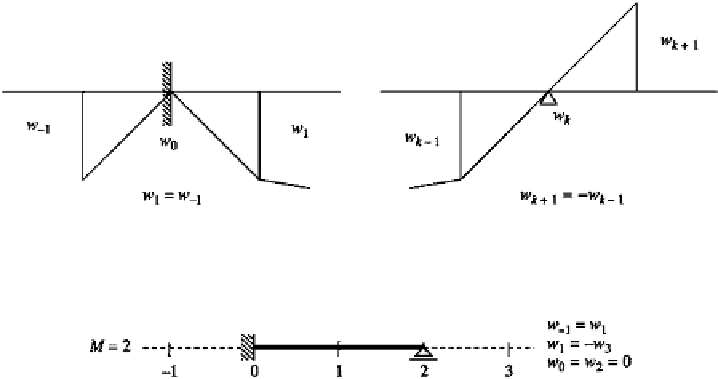Information Technology Reference
In-Depth Information
The governing differential equation for a beam with axial force and with
p
z
=
0is
[Eq. (11.31)]
i
v
2
w
=
2
w
+
α
0
,
α
=
P
/
EI
(1)
i
v
w
From Chapter 8, Table 8.1, the central difference expressions for
w
and
are
1
h
2
w
k
=
(w
k
−
1
−
2
w
k
+
w
k
+
1
)
(2a)
1
h
4
i
k
w
=
(w
−
4
w
+
6
w
−
4
w
+
w
)
(2b)
k
−
2
k
−
1
k
k
+
1
k
+
2
where
h
is length of interval.
The boundary conditions of
w
0
=
w
x
=
L
=
0 and
0 applied to the central difference
1
2
h
w
w
[
w
0
=
(w
−
w
−
1
)
w
=
w
−
1
and
w
=−
w
expressions for
and
and (2a)] give
1
,
1
1
k
+
1
k
−
respectively (see Fig. 11.43).
Two Segments
(
M
=
2, Fig. 11.44)
In this case,
h
=
length
/
M
=
L
/
2, and at node 1, the substitution of (2) into (1) gives
2
h
2
(w
1
h
4
(w
−
1
)
+
α
−
4
w
+
6
w
−
4
w
+
w
−
2
w
+
w
)
=
0
(3)
0
1
2
3
0
1
2
With the relations
w
−
1
=
w
1
,
w
=−
w
1
, and the boundary conditions
w
=
w
=
0
3
0
2
0or
3
2
2
h
2
2
1
h
4
6
−
α
w
w
=
h
2
−
α
w
=
0
.
(4)
1
1
1
2
h
2
This gives
α
=
3
/
=
P
/
EI
. Finally, we conclude that
3
EI
h
2
12
EI
L
2
=
=
P
cr
(5)
FIGURE 11.43
Finite difference boundary conditions for the beam of Fig. 11.28.
FIGURE 11.44
Central differences with two segments.


















Search WWH ::

Custom Search